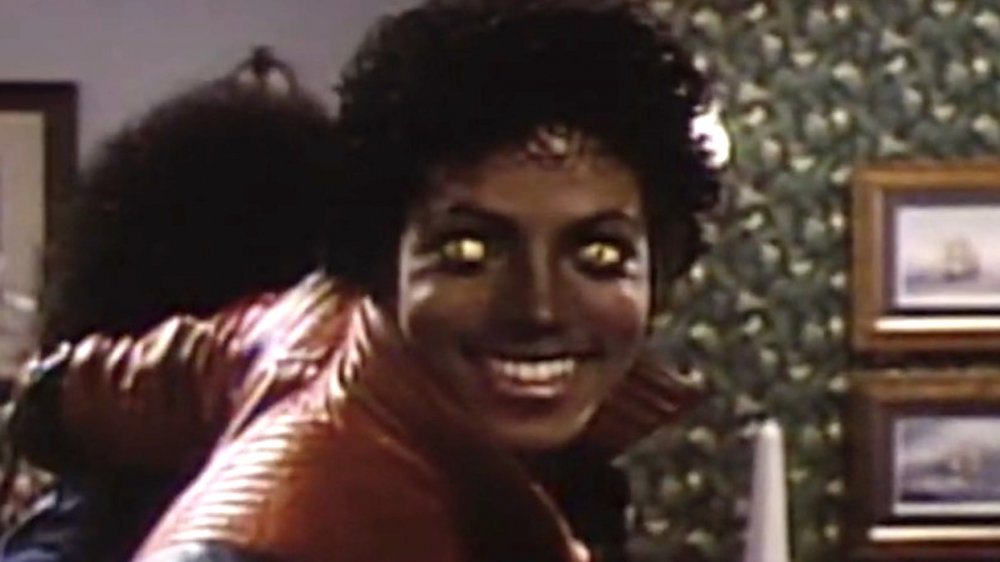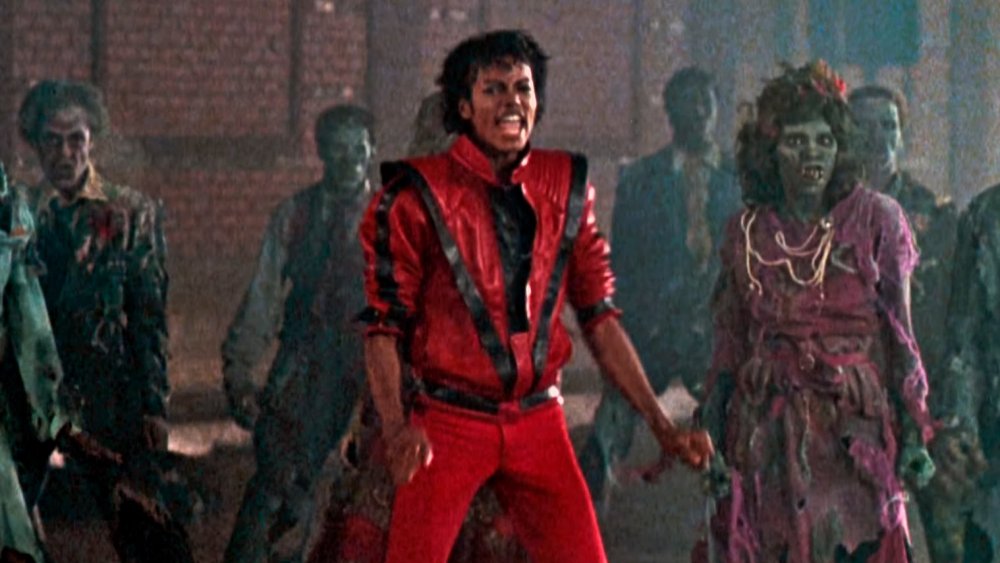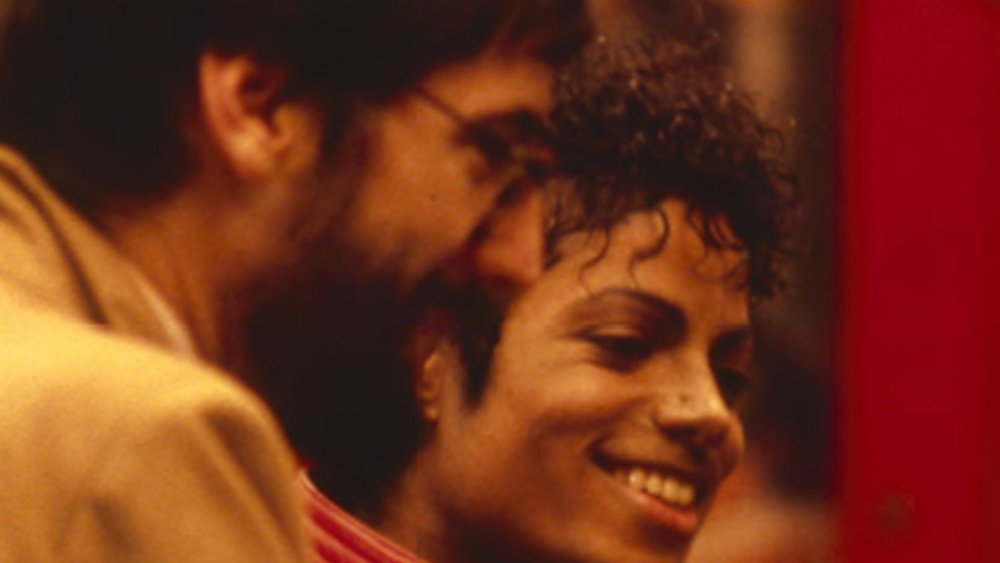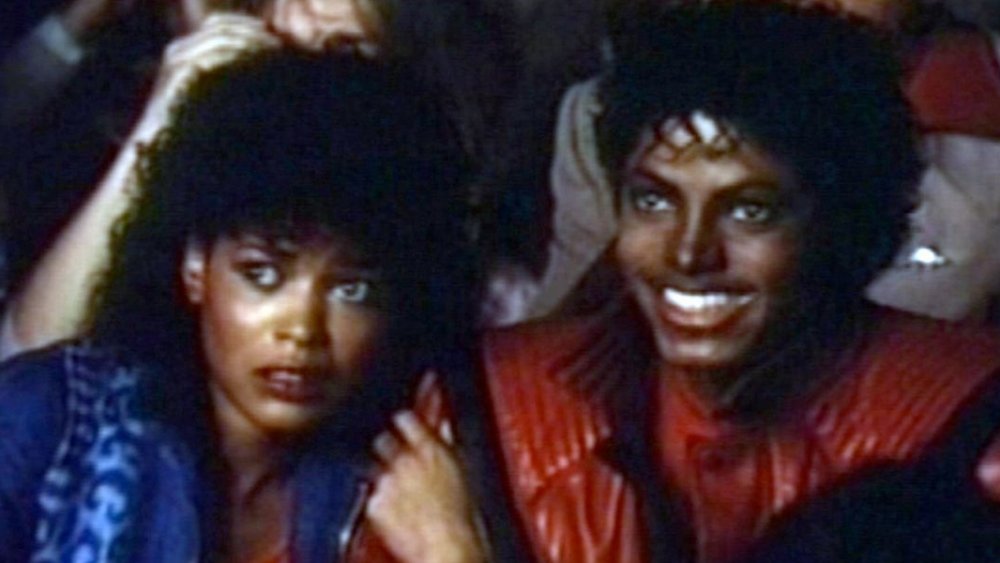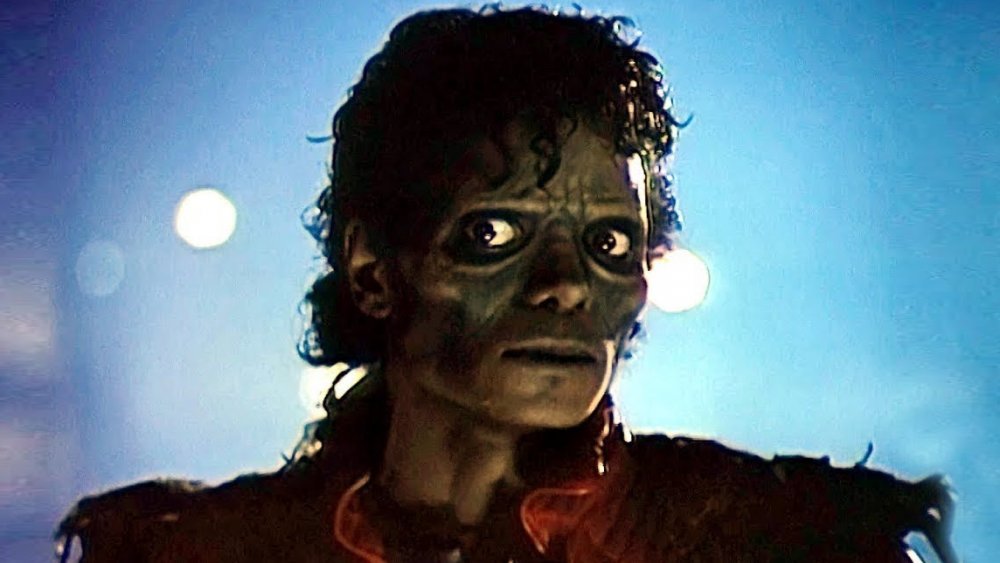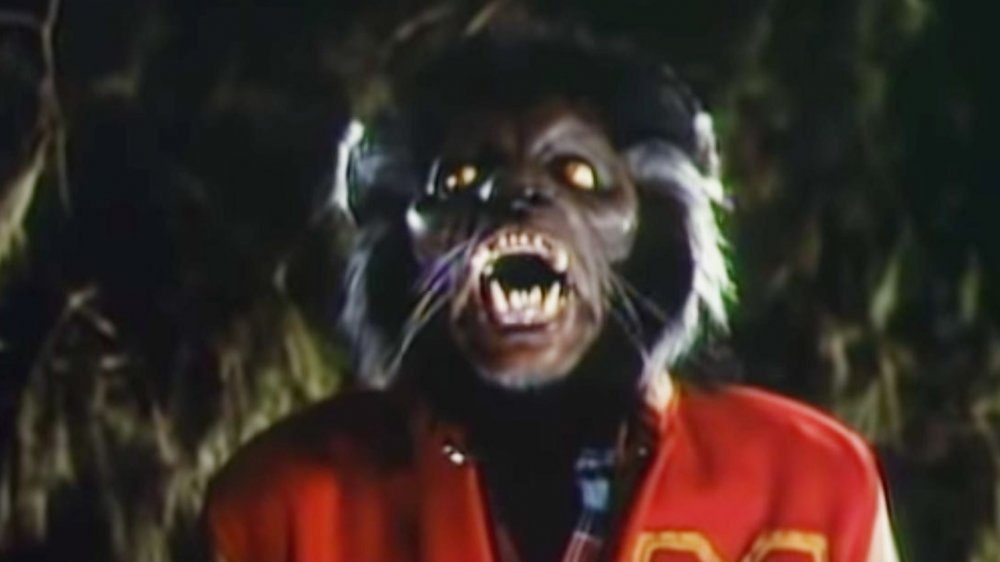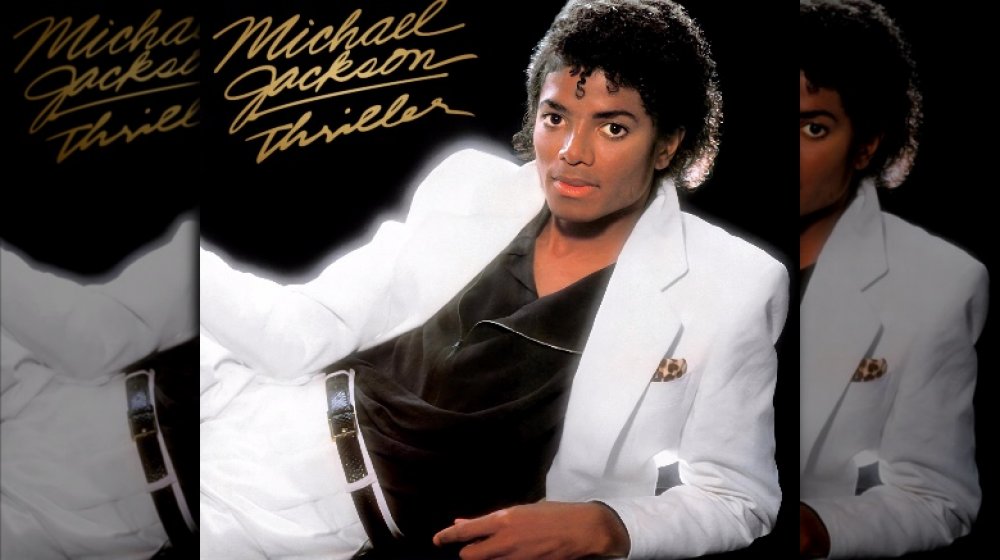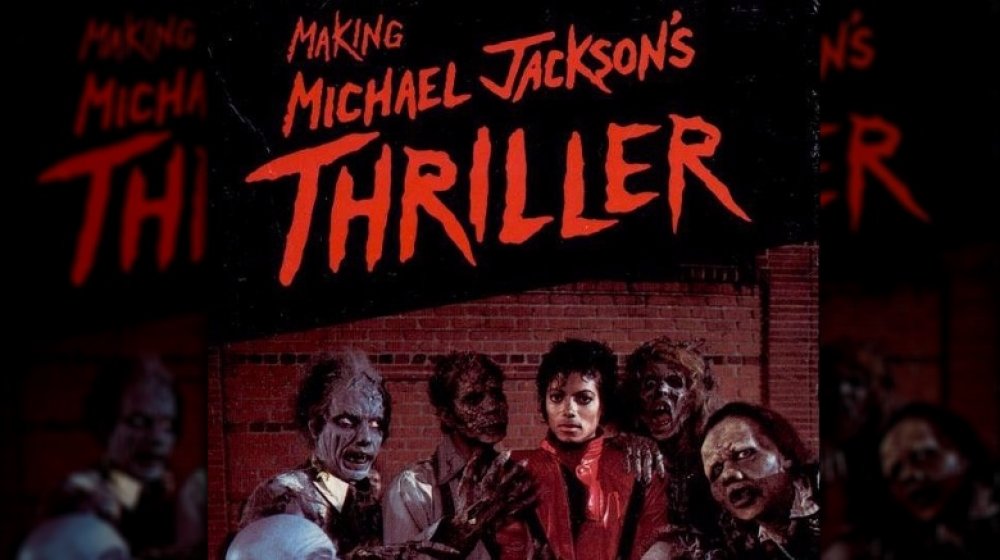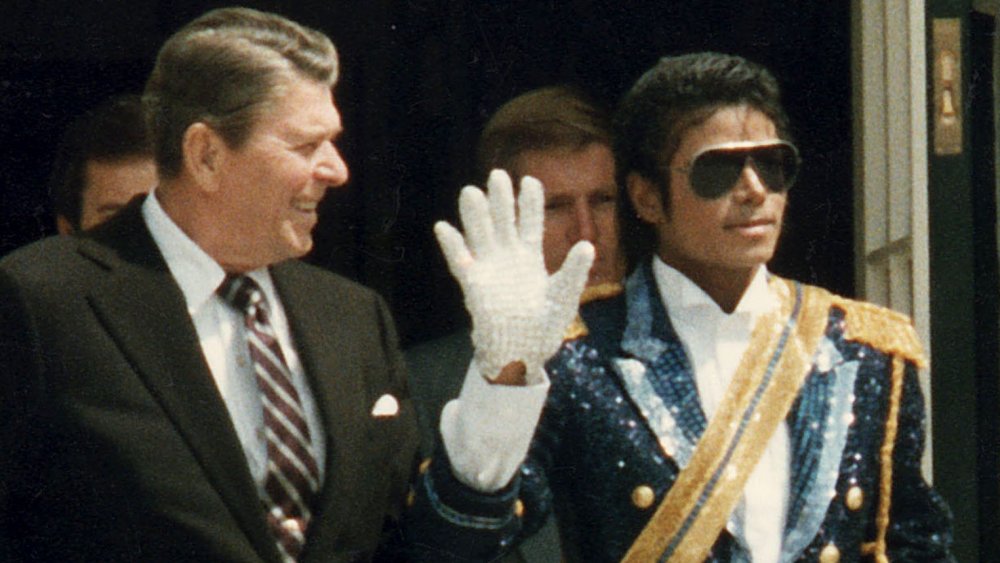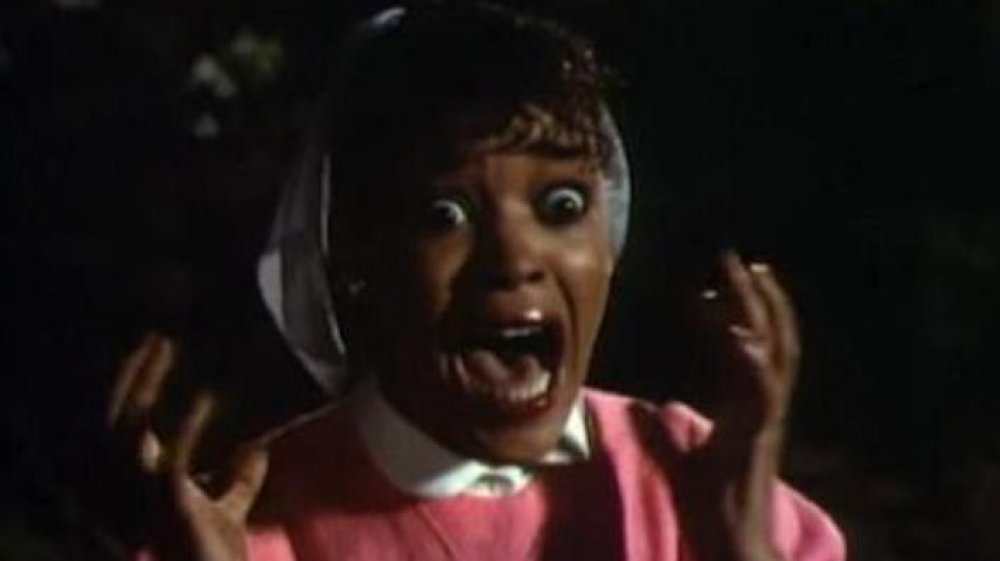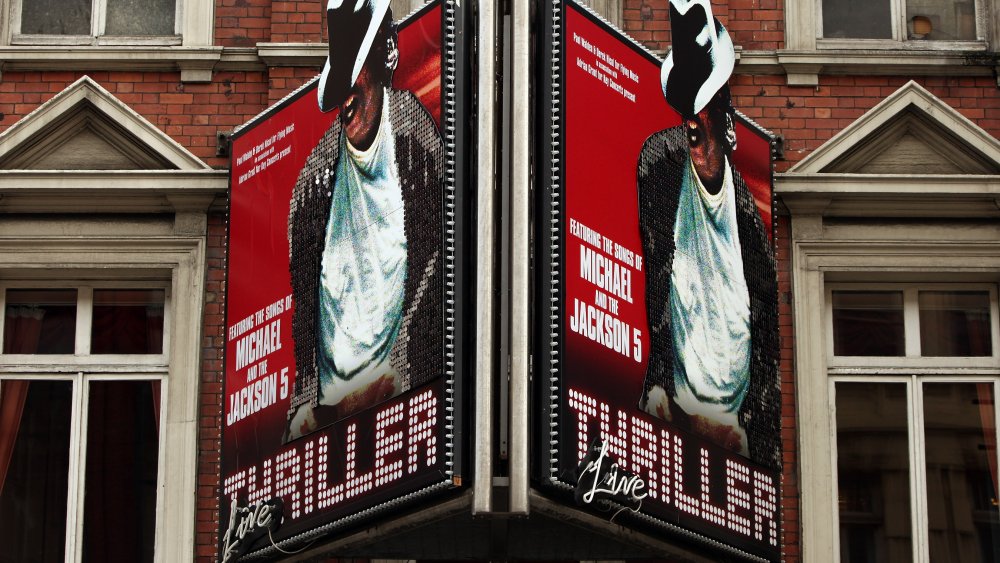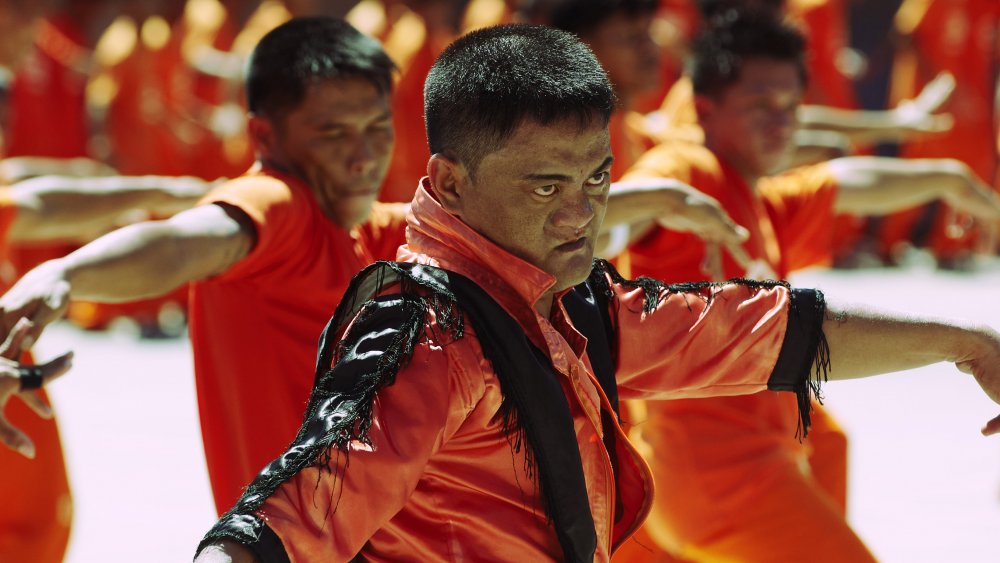The Untold Truth Of Michael Jackson's Thriller Video
Michael Jackson had a huge 1983. He took both "Beat It" and "Billie Jean" to #1, debuted his signature "Moonwalk" dance move to stunned and delighted fans, sold millions of copies of his album Thriller, and then starred in one of the most popular, famous, and well-produced music videos of all time. Actually, "Thriller" is more of a short film, a nearly 14-minute horror movie about a young man who's "not like other guys" who transforms into a werewolf-like monster, terrorizes his date, and dances like a zombie while looking cool in a red leather jacket.
The clips promoting "Thriller" helped turn MTV into a vital cultural force, solidified Jackson's stature as the "King of Pop," and significantly raised both the quality and expectations of music videos. "Thriller" remains a classic, as well as an unprecedented moment in music and film, and it wasn't easy to pull off. Here's the inside story on the development, production, and impact of the video for Michael Jackson's spookiest hit.
"Thriller" had to be creatively budgeted
When Michael Jackson's Thriller started to drop down the charts in 1983, according to Vanity Fair, Jackson grew unnerved and pressed executives on how to restore the LP to its #1 perch. Epic Records head of promotions Frank DiLeo suggested a third music video, for the album's title track, which wasn't even slated to be a single. "It's simple — all you've got to do is dance, sing, and make it scary," DiLeo says he told Jackson at the time. However, Epic wouldn't pay for it — the label spent $250,000 on the video for "Billie Jean" but made Jackson pay the $150,000 budget for "Beat It" himself. The proposed cost of the "Thriller" video: slightly less than $1 million.
After a screaming, profanity-laden phone call with Jackson and director John Landis, CBS Records head Walter Yetnikoff offered up $100,000, leaving the creative team to find the rest of the money elsewhere. Landis' production partner George Folsey and Jackson's lawyer John Branca hatched a plan: raise money by pre-selling the rights to a behind-the-scenes documentary shot during "Thriller" production. MTV, which, to that point, had never paid for content, contributed $250,000, and Showtime paid $300,000. According to The Guardian, Jackson made up a lot of the difference out of his own pocket.
How John Landis came to direct "Thriller"
In August 1983, film director John Landis received a phone call from Michael Jackson. Landis had helmed several big movies, including the horror-comedy An American Werewolf in London, which Jackson so enjoyed (per Vanity Fair) that he wanted the director to tell another werewolf story and helm his "Thriller" video. The singer and the filmmaker met, and Landis dismissed the notion of presenting "Thriller" as a typical, cheaply made music video. Instead, he thought, it would be shot like a real movie, on classy 35-millimeter film stock. A musical number set to "Thriller" (the song) would comprise most of the video, but it would also have a scripted drawing device. Landis and Jackson worked out a story about a guy who takes a young woman on a date and transforms into a bloodthirsty horror movie monster before her very eyes. Jackson was all in, especially after Landis said he could probably get An American Werewolf in London makeup master Rick Baker involved.
One major part of the early concept was rejected. Landis told The Guardian that they initially planned to make Jackson turn into a four-legged creature. "We came to the conclusion that if Michael was going to dance, it would be a hell of a lot easier for his monster to have two legs instead of four." And so, that's what happened, although Jackson's character doesn't, per common knowledge, become a werewolf. According to Baker, he technically portrays a "werecat."
Michael Jackson and his costar got along famously
"Thriller" hit MTV and other outlets in 1983, the same year that the risqué (for the time) Flashdance was a hit in movie theaters and made a star out of Jennifer Beals. According to Vanity Fair, Beals passed on the female role in the "Thriller" video, and after a lengthy search, director John Landis cast Ola Ray as the poodle-skirt-wearing young woman in the video's fake horror film as well as Michael Jackson's date who witnesses his transformation into a monster. "I auditioned a lot of girls and this girl Ola Ray — first of all, she was crazy for Michael," Landis said. "She had such a great smile."
Only later did Landis realize that Ray was a former Playboy Playmate, which threatened her involvement in the video because Jackson thought it might come across as improper for him to be sharing the screen with a nude model. Landis talked Jackson out of getting a new actress by reminding him that Ray was a Playmate in Playboy, not in "Thriller." The actress and the musician wound up getting along just fine — more than fine, actually. "I had some intimate moments with him in his trailer," Ray said. "I won't say that I have seen him in his birthday suit but close enough."
"Thriller" scared Michael Jackson
Before any of the "Thriller" fun — monster transformations, choreographed zombie dances, creepy yellow eyes — the video begins with a brief bit of text on screen. "Due to my strong personal convictions," the disclaimer credited to Michael Jackson reads, "I wish to stress that this film in no way endorses a belief in the occult." That's a pretty serious statement, and one that makes the silly horror movie-inspired fun to follow seem like it's going to be a lot darker and menacing than it is. It's also one Jackson felt personally compelled to include.
After production on the video wrapped, Jackson was told by leaders of his church (Jackson was a practicing member of the Jehovah's Witness faith) that they thought "Thriller" encouraged demon worship, and if it were released, he'd be excommunicated. Thoroughly upset, Jackson ordered his lawyer, John Branca, to destroy the "Thriller" negatives. Branca wouldn't do it, and he instead locked up the footage and gave Jackson the idea to let "Thriller" out, but just with a denouncing disclaimer tacked on to the start. The singer liked that idea and later told Jehovah's Witness publication Awake that he "just intended to do a good, fun short film, not to purposely bring to the screen something to scare people or to do anything bad."
The "Thriller" video is full of weighty metaphors
The premise of Michael Jackson's "Thriller" music video is fairly straightforward. Jackson's character takes his date (Ola Ray) to a horror movie and then makes her life into one when he transforms into a monstrous creature and leads a horde of other scary creatures both ghoulish and undead. But for director John Landis, "Thriller" was about something more: sex, primarily. According to Vanity Fair, Landis directed Jackson to add an element of sexual forwardness to his role, with an eye toward interesting the singer's many female fans by making him appear more manly and virile.
Additionally, Landis equates the process of man turning to beast, in "Thriller" and in other werewolf-based movies (such as the director's own An American Werewolf in London), with puberty. "In adolescence, youngsters begin to grow hair in unexpected places and parts of their anatomy swell and grow," Landis wrote in Monsters in Movies. "Everyone experiences these physical transformations in their bodies and new, unfamiliar sexual thoughts in their minds. No wonder we readily accept the concept of a literal metamorphosis.
"Thriller" the video made Thriller the album a blockbuster
"Thriller," of course, came from the Michael Jackson album also called Thriller. The record was a major hit that sold millions of copies and spawned numerous hit singles, which, in turn, led to more album sales. The LP is only nine tracks long, and seven of those of those were commercially released singles: "The Girl is Mine," "Wanna Be Startin' Somethin'," "Human Nature," and "P.Y. T. (Pretty Young Thing)," all hit the top 10 of the Billboard Hot 100, with "Billie Jean" and "Beat It" going the extra mile, all the way to #1.
Title track "Thriller" was the seventh and final Thriller single, released to stores and radio in January 1984, well over a year after the album debuted. The cultural event that was the video for "Thriller" pushed sales of the single, too, and the song hit #4 on the pop chart. The horror mini-movie also directly led to Thriller flying off store shelves again. Millions of people who somehow hadn't yet purchased Thriller were inspired to do so, and during the peak of the video's popularity, the album sold more than a million copies a week, according to Vanity Fair. By the time Thriller's sales cycle wound down in 1984, it was the best-selling LP of all time in the United States, with sales of 33 million.
"Thriller" jumpstarted home video
Michael Jackson's "Thriller" clip permanently elevated the medium of music video to artistic and cinematic relevance at a time when it was still relatively new and directionless. "Thriller" also helped steer toward importance and bring a new standard operating protocol to another kind of video — home video.
In the 1980s, millions of consumers were purchasing their first VCRs. Either in the VHS or Betamax format, the TV accessory allowed them to watch movies or other content at home via a cassette borrowed for the cost of a few bucks from a local video rental outlet. This was the business model in home video for most of the early to mid-1980s: Studios and publishers charged about $90 for tapes and sold almost exclusively to rental stores, which would then charge customers a few bucks to rent it for a day or two. A videocassette of "Thriller" opened the door to priced-to-own videos.
According to Vanity Fair, Vestron Video helped offset the high production cost of "Thriller" by paying for the VHS and Betamax distribution rights for the Making Michael Jackson's Thriller documentary and then gave it a $29.95 retail price tag. Within just a few months of release in November 1983, it had sold over a million copies, easily making it the best-selling home video ever to that point. There's even data to suggest that the existence of Making Michael Jackson's Thriller helped fuel the massive rise of VCR sales in late 1983.
"Thriller" won (and lost) a lot of awards
"Thriller" was a watershed moment in music video. Prior to its production in 1983, music videos weren't taken seriously or considered anything more than a way to cheaply promote a single or an album. Early music videos were usually shot on video, not film, adding a cheap look to a cheap production — a singer or a band might do little more than stand in an unadorned studio and lip-sync to their recording. "Thriller" was one of the first music videos to show that the medium carried the potential for greatness, and not only did critics acknowledge its importance, but they kept doing so for years afterward.
In 1984, Making Michael Jackson's Thriller won the Grammy Award for Best Video Album, and in a 1999 end-of-the-century countdown, MTV named "Thriller" the #1 music video of all time. Less than two years later, sister network VH1 would also name "Thriller" the top video ever made. In 2009, the Library of Congress added "Thriller" to the National Film Registry, naming it part of its collection of films that should be "preserved as cultural, artistic, and/or historical treasures for generations to come," according to LA Weekly. And yet despite all these fancy awards, "Thriller" didn't win the one prize that seemed like a lock. At the inaugural MTV Video Music Awards in 1984, "Thriller" surprisingly lost Video of the Year to the Cars' "You Might Think."
Ola Ray sued over "Thriller"
Ola Ray took home a lot of memories and stories from her time co-starring in Michael Jackson's landmark "Thriller" music video. And as later legal filings would indicate, that's about all the actress and model took home.
In May 2009, Ray sued Jackson, along with his production company, for breach of contract. The actress claimed that back in the 1980s, she was promised a portion of the "Thriller" profits (2.5 percent, according to Courthouse News), and yet, more than two decades later, she hadn't received any money since some initial payments. "We don't believe they were complete, and they were never timely," Ray's attorney, Jason Feldman, told the New York Daily News, which reported that the most substantial chunk of money the actress received came in 1998 — 15 years after "Thriller" was shot.
Jackson died a few weeks after the suit was filed, and according to TMZ, the singer's estate settled with Ray in 2013 to the tune of $75,000. In 2017, Ray had to file a lawsuit again, when she alleged that she wasn't paid her share for a 3-D re-release of the "Thriller" video.
John Landis sued over "Thriller"
The massively successful "Thriller" video was a close collaboration between performer Michael Jackson and director John Landis, although it would seem that of the pair, only Jackson greatly benefited financially from the project. In January 2009, nearly three decades after production on the video wrapped, Landis sued Jackson and his production company for having failed to fork over what was due over the years. "The Thriller video became a worldwide megahit and an iconic pop culture phenomenon that has continued to generate profits for defendants Optimum Productions and Michael Jackson, who have wrongfully refused to pay or account for such profits to plaintiff," the suit read (via The Guardian).
The suit alleged that Landis didn't receive his promised 50-percent cut of the profits and that Jackson and company acted with "fraudulent, malicious, and oppressive conduct" in withholding what The Hollywood Reporter said amounted to about $2.3 million. Jackson died about six months later, and his estate settled with Landis in 2012.
"Thriller" live?
Some of the biggest Broadway productions of recent years are musicals based on preexisting, well-known media. After all, if they're going to pay a few hundreds bucks for a ticket, patrons can at least have some idea of what they're getting into beforehand when they line up to see Mean Girls (based on a hit movie) or Mamma Mia! (based on the familiar songs of ABBA). As such, Michael Jackson's "Thriller" — the narrative short horror musical video, not the song or album of the same name — is ripe for mainstream theatrical adaptation.
In 2009, according to Broadway World, theater production company the Nederlander Organization announced that it had obtained the rights to Jackson's magnum opus and would be making a big musical based specifically on the "Thriller" video. "I love the idea of making Thriller a musical," said James L. Nederlander. "Girl meets boy, they fall in love, boy has big secret, now what." This particular Thriller musical is not to be confused with Thriller Live, a Michael Jackson-themed theatrical experience that ran in London's West End (the British Broadway) for well over a decade.
"Thriller" lives
"Thriller" never really stopped being popular. As of September 2020, the video, hosted by Michael Jackson's official YouTube account, had racked up nearly 700 million views. This is to say nothing of the countless videos, viral and otherwise, of people re-creating the familiar "Thriller" dance moves — particularly the stylized zombie movements — at weddings, block parties, and Halloween celebrations. Certainly the largest example of the phenomenon: In 2009, 13,957 people in Mexico performed the "Thriller" dance all at once, setting a Guinness World Record.
What's likely the most popular second-generation "Thriller" video came from an unlikely place: a prison in the Philippines. According to NPR, government security consultant Byron Garcia instituted an exercise program in the mid-2000s at the Cebu Provincial Detention and Rehabilitation Center. Sessions had been previously sparsely attended, so Garcia introduced elaborately choreographed dance routines, and before long, as many as 1,500 inmates reported to the prison yard to learn some moves. Garcia taped and uploaded videos of the sessions to YouTube, and in 2007, the one of the "CPDRC Dancing Inmates" doing the "Thriller" dance hit big and went viral. As of 2020, more than 59 million people had watched the sea of orange-clad people amble and groove like zombie-monsters.
